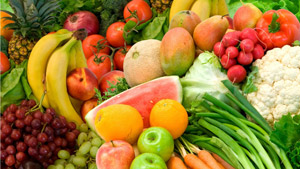
by Kari Hartel, RD, LD
Program Coordinator, Cooking Matters, Operation Food Search
Summer is upon us and there is an abundance of fresh produce available in stores, farmers’ markets and possibly your own backyard if you’re lucky enough to have your own garden. What better time to enjoy the delicious flavors of fresh fruits and vegetables than now!
Eating plenty of fruits and vegetables plays a key role in maintaining a healthy weight. It also slashes your risk for heart disease, diabetes, stroke, cancer and joint conditions. Scientists are continuing to find that diets high in fruits and vegetables may help prevent or even treat other ailments as well.
The U.S. Centers for Disease Control and Prevention reports that only 14% of adults eat three servings of vegetables and two servings of fruit each day, reaching the minimum recommended amount of fruit and vegetable intake per day. Some common reasons people cite for not meeting the recommendations include: limited access to fruits and vegetables, the misconception that frozen and canned fruits and vegetables are somehow less nutritious and the time required to prepare fresh fruits and vegetables. Others say that fresh produce is more expensive. Some people also state that they don’t know how to prepare fruits and vegetables in a way that makes them taste good.
The fact that produce is good for our bodies is not a hard concept to grasp. The problem is that people are choosing to consume foods that have been dubbed “junk food” in place of the nutrition powerhouses otherwise known as fruits and vegetables. These foods—fast food, high-calorie snacks, fat-laden frozen dinners, oversized restaurant meals and sugary beverages—are providing loads of calories, fat (especially artery-clogging saturated fat) and sodium but little to no beneficial nutrients.
Tips for Getting More Fruits & Vegetables
- Try adding mushrooms, tomatoes, onions, bell peppers or spinach to your morning eggs.
- Top your breakfast cereal with pieces of fruit—both fresh and frozen work.
- Add a mashed banana to oatmeal.
- Add thinly sliced vegetables to sandwiches and wraps.
- Throw in spinach (fresh, frozen or canned) to pasta dishes.
- Bulk up your meatloaf by adding chopped up carrots, zucchini, onions or peppers.
- Top your otherwise-boring pizza with chopped veggies.
- Add shredded vegetables into your pasta sauce.
- Snack on sliced raw vegetables dipped in low-fat dip, hummus or peanut butter.
- Stash fresh fruit in your bag to have available for a quick snack.
- Stir in fruit (fresh, frozen, canned or dried) into your yogurt for a quick, healthy snack
Produce in Season in July: Apricots, Bananas, Beets, Bell Peppers, Blackberries, Blueberries, Cantaloupe, Cherries, Corn, Cucumbers, Eggplant, Garlic, Grapefruits, Grapes, Green Beans, Honeydew Melon, Kiwifruit, Lima Beans, Mushrooms, Nectarine, Peaches, Peas, Plums, Radishes, Raspberries, Strawberries, Summer Squash and Zucchini, Tomatillos, Tomatoes, Watermelon.
For more information on food and nutrition, visit www.operationfoodsearch.org.


